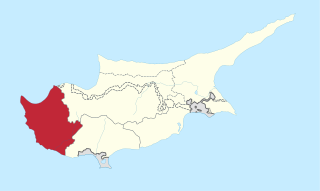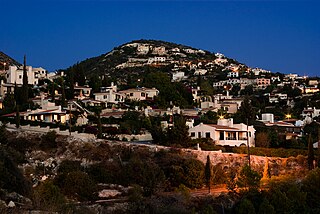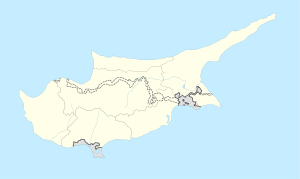
Paphos, also spelled as Pafos, is a coastal city in southwest Cyprus and the capital of Paphos District. In classical antiquity, two locations were called Paphos: Old Paphos, today known as Kouklia, and New Paphos. It is the fourth-largest city in the country, after Nicosia, Limassol and Larnaca, with an urban population of 63,600 in 2018.

The Paphos District, or simply Paphos, is one of the six districts of Cyprus and it is situated in the western part of Cyprus. Its main town and capital is Paphos. The entire district is controlled by the internationally recognised government of Cyprus. There are four municipalities in Paphos District: Paphos, Yeroskipou, Peyia, and Polis Chrysochous.

Tsada is a relatively big village 8 km North of Paphos city center. Although the proximity between them, the 612 m elevation difference gives to the Tsada area a totally different identity. It receives 610 millimetres (24 in) of precipitation annually. The climate is much cooler all year long and it also is one of the few areas in the Paphos District that snows almost every year by the end of January. Tsada was the home village of EOKA member Evagoras Pallikarides. Although the history of the village can be counted 500 years ago, there is no significant architectural character, and only a few residences were reconstructed in the traditional way. The Melisovouno hill between Tsada and Koili village hosts Paphos television and radio antenna.
Fyti is a village in the Paphos District of Cyprus. It is situated on a plateau 25 km north-east of Paphos and 20 km south-east of Polis. There are several small villages within a 3 km radius of Fyti, including Lasa, Kritou Marottou and Anadiou, all residing at an average altitude of 680 m.

Tala is a large suburban village 6 km north of Paphos, Cyprus. Many non-Cypriots have moved here permanently or have a summer home in Tala. Agios Neophytos Monastery is 1 km north. Is located 290 meters above sea level. Tala receives an average annual rainfall of about 520 millimeters; grapevines, citrus fruits, locust, olive, almond, and walnut trees, cereals, forage plants, vegetables, and a few banana trees are cultivated in the region. As far as stockbreeding is concerned, it is limited.

Koilani is a village in the Limassol District of Cyprus, located 3 kilometres (1.9 mi) south of Pera Pedi.
Mesana is a village in the Paphos District of Cyprus, located 2 km northeast of Salamiou.
Psathi is a village in the Paphos District of Cyprus, located 3 km west of Agios Dimitrianos. Psathi is located at 488m above sea level.
Polemi is a village in the Paphos District of Cyprus.
Kallepia is a village in the Paphos District of Cyprus, located 2 km south of Letymvou. The village of Moro Nero is part of the municipality. It is located 497 metres (1,631 ft) above sea level. Its peak is around 590 metres (1,940 ft). It receives 630 millimetres (25 in) of rainfall annually.
Mesogi is a village in the Paphos District of Cyprus, located 5 km north of Paphos. It's located 306 m above sea level. It receives approximately 540 millimetres of rainfall annually. For horse riding enthusiasts, Mesogi also has a horse ranch, which offers a walk in the nature of the area, riding on the horses.

Tremithousa is a village in the Paphos District of Cyprus, located 7 km north of Paphos. Tremithousa is located 294 m above sea level. Tremithousa is located near Mesa Chorio and Mesogi Village. Tremithousa receives an average annual rainfall of about 520 millimeters; vines of winemaking varieties, vegetables, cereals, forage plants, citrus, almond, and walnut trees, and legumes are cultivated in the region. The village has a reputation for the aromatic and tasty honey that it produces. Tremithousa connects in the north to the monastery of Agios Neofytos, in the northeast with the village of Tala, and in the east with the main road of Tsada – Polis.
Koili is a village in the Paphos District of Cyprus, located 2 kilometres (1.2 mi) northwest of Tsada.
Dhrousha is a village in the Paphos District of Cyprus, located 10 km south of Polis Chrysochous. It's located at 640 m above sea level.

Giolou is a village in the Paphos District of Cyprus, located 20 km North of Paphos and 15 km South of Polis Chrysochous. At an altitude of about 300 meters from the sea, the settlement of Giolou is connected to the southwest and north to the main road that leads to Polis Chrysochous and Latsi, which in fact led to the identification of its name with the Turkish Cypriot word “yiol” and later with the wind god, Aeolus. The most prevalent version for the origins of its name, however, mentions the name of the feudal owner who had the village in his possession during the Byzantium era or during the period of the Frankish rule.

Kritou Terra is a village in the Paphos District of Cyprus, located 3 km east of Dhrousha. Kritou Terra is located 479 m above sea level. It receives 630 mm of rainfall annually. Situated in the area of Laona, as the wider area is called and in a landscape surrounded by high mountain peaks and to the north overlooking the Gulf of Chrysochous, Kritou Terra is built at an altitude of 465 meters, is one of the ampelochoria of the island and is considered one of the most beautiful and picturesque villages of the province. It has fantastic climatic conditions and because it’s located by the third biggest spring in Cyprus it’s green all year round.
Philousa Kelokedharon is a village in the Paphos District of Cyprus, located 4 km east of Arminou. The village of Filousa Kelokedaron is located in the province of Pafos. It is 40 km from the cities of Pafos and Limassol. Filousa Kelokedaron is one of the first villages of the Darizou valley, 15 km southwest of Platres, in the area of Omodos - Arsos. It is adjacent to the villages of Pretori, Kedares and Agios Nikolaos.

Choli is a village in the Paphos District of Cyprus, located 7 km south of Polis Chrysochous. It is home to three churches: the late fifteenth- to early sixteenth-century Arkhángelos Mikaïl church, the fifteenth-century Panayía Odhiyítria Orthodox church and the twelfth-century St George church.

Paphos Archaeological Park contains the major part of the important ancient Greek and Roman city and is located in Paphos, southwest Cyprus. The park, still under excavation, is within the Nea Pafos section of the coastal city.

Neo Chorio is a village in the Paphos District of Cyprus, about 8 km west of Polis. Until 1958, it had a mixed Greek- and Turkish Cypriot population with a Greek Cypriot majority. Amid the intercommunal violence, the Turkish Cypriot inhabitants of Neo Chorio fled to Androlykou, a nearby Turkish Cypriot village. In 1975, following the Turkish invasion of the previous year and subsequent division of the island, most Turkish Cypriots of Neo Chorio resettled in Myrtou, now in Northern Cyprus. In 2011, Neo Chorio had a population of 519. Since July 1998, Neo Chorio has also been home to Anassa Hotel, a luxury 5* beach resort owned by the Thanos Hotels Group.












